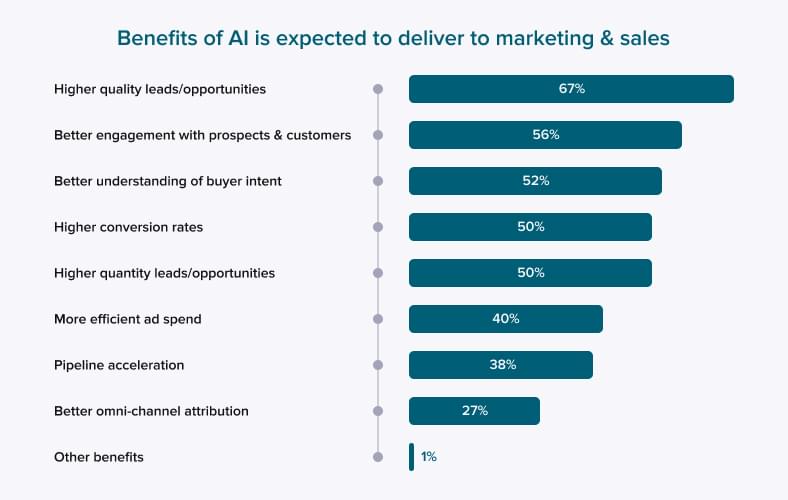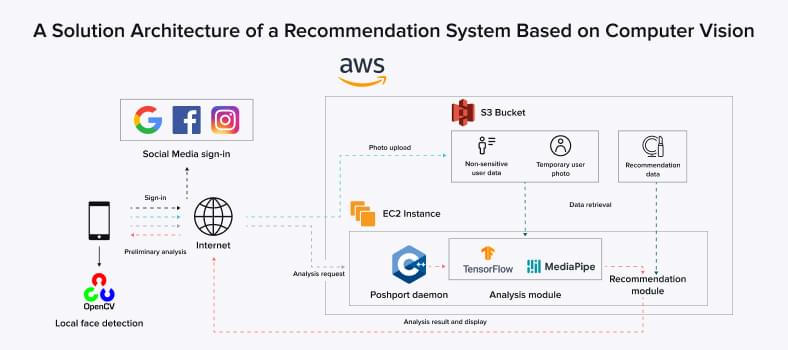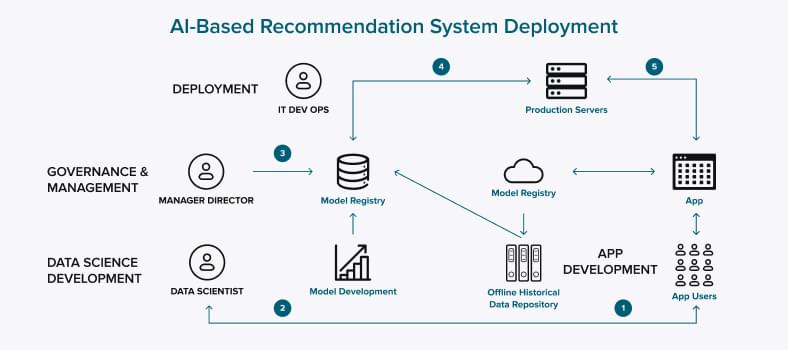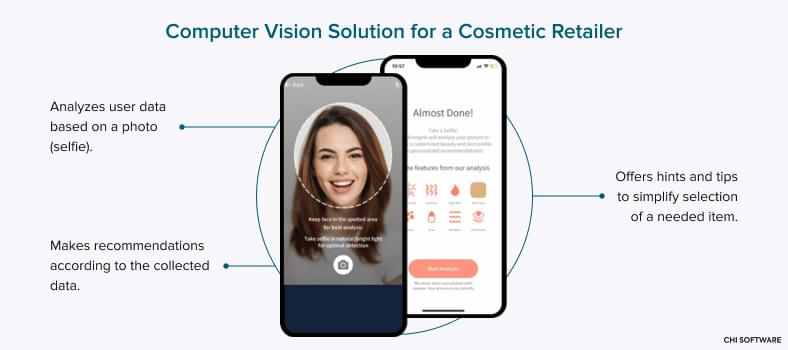Chatbots are rising! By 2027, one out of four businesses will employ them as a primary tool for customer service. It is easy to see why. Chatbots are always on the alert, able to manage multiple tasks at once. They are also efficient and friendly thanks to the latest innovations in generative AI. But a crucial question arises: how secure...
How well do you know your customers? The answer to this question has become increasingly important since the 1990s.
The first steps toward personalization were made when CRM systems appeared and marketers accessed basic customer data (names, location, age, gender, etc.). Now, in 2023, businesses can analyze the client’s behavior and make the most personal offerings ever using AI-powered personalization.
Moreover, 76% of customers get frustrated if they do not receive personal recommendations. In other words, if you do not recommend, you drop out of the big game. Is there anything you can do right now? There are many ways to answer this question, so we will not waste a single minute.
Our article uncovers what stands behind AI-driven personalization with use cases and implementation tips.Traditions First. What Does Old-School Personalization Look Like?
5 Examples of How to Use AI for Personalization
Personalization is a broad sphere with industry-specific use cases. But our task today is to review practices commonly used by businesses of various sizes and domains.

1. Personalized content
AI-powered marketing enables extraordinary detailing. Now businesses can pay special attention to every bit of content, which greatly impacts customer reactions. Starting from a subject line up to greetings and recommendations based on previous interactions, brands can create unique messages for each of their clients.
2. Chatbots
Embedded conversational robots (chatbots) are another way to collect comprehensive user data. It is a program using AI and NLP (Natural Language Processing) to provide personalized interactions and collect user queries and feedback.
Not only can these smart robots easily understand requests and provide relevant responses, but they also collect valuable user data. It is a proven way to build up an NLP-based recommendation system.
CHI Software specializes in providing top-notch ChatGPT app development services, ensuring a seamless and engaging conversational experience for users across various platforms.
3. Retargeting
Every visitor leaves a trace on your web platform by clicking on product pages, browsing through catalog categories, adding items to the cart, etc. You can use all these actions to your benefit with intelligent retargeting. While you are busy creating attractive ads, machine learning algorithms can give you a hint about the content appealing to your target audience.
4. Notifications based on certain events
This use case applies to mobile app users in particular. You know for sure that those who downloaded your application are already interested in your brand. Now you can improve their experience by reacting to certain events, such as a changed location, a product from the wish list appearing in stock, an unfinished purchase, etc.
5. Sentiment analysis
Sentiment analysis relies on NLP, biometrics, computational linguistics, and other spheres to extract valuable information from the vast volumes of raw data. Let us say, an algorithm has to analyze customer opinions about a product. It will scan text reviews, distinguish words with positive and negative connotations, and make a conclusion. At the moment, algorithms are learning to analyze less explicit sentiments.
CHI Software Case Study: Computer Vision Solution with a Recommendation System Powered by ChatGPT
Personal recommendations at a beauty store have always been a delicate matter. Customers differ in their skin tone, age, color type, and personal preferences. Needless to say, personalized recommendations in this case are a complex task for salespeople.
But what if you assign this job to intelligent algorithms? Our client, a US-based cosmetic retailer, decided to do just that.
How did it all begin?
Our client has a large variety of products and a wide audience, so a proper level of personalization was possible only with a lot of trained consultants. To minimize human involvement and increase recommendation efficiency, it was decided to implement AI algorithms.
What are the key product features?
- Face analysis based on computer vision capabilities. The solution processes the data received from the user’s selfie.
- A ChatGPT-powered recommendation system offering products based on the user data collected from a photo.
- Additional tips that help buyers make their choice faster, considering individual requests and preferences.

What results can AI implementation help you achieve (with numbers)?
Artificial intelligence is not just a fancy trend. It is an effective instrument to achieve specific business goals. These are the primary metrics for our client:
- Increase in sales by up to 10%,
- Customer retention growth by 5-7%,
- Minimizing stockout by 5-8%,
- Revenue growth by 10%.
As you can see, one recommendation engine can bring a positive impact on the operations of several business departments at once.
Now, let us step back to the very beginning of rewind the project and review the development process. You may be surprised but creating AI products starts long before algorithm building.
Tips from CHI Software Engineers: How to Get Started (and Move On) with AI-Powered Recommendations?
All AI projects require thorough research at the start. Solutions based on algorithms are never the same and work differently for different companies. What is more important, not all organizations need AI implementation. Understanding goals and circumstances can save you a decent amount of time and money. So, let us begin.
1. Define business goals and issues
It is often easier said than done. A lot of companies rush to start development and overlook what is going on inside their business. We strongly recommend considering an existing business first and only then focusing on new developments.
AI projects start with discussions and finding the common ground between a development vendor (us) and a company. At CHI Software, we have a dedicated team of business analysts who help conduct the discovery phase and set up a direction for a future project.
This is what you should be ready to discuss first:
- What is the final goal of building your recommendation system? Try to be very specific at this point and follow SMART principles. If you want to increase sales, what sum and deadline are you aiming at? Or if your goal is to increase conversions, then by what figure?
- Do you really need an AI-powered recommendation system? The answer will become clear as soon as you answer the previous question. There is a chance that a newsletter with static content can solve your problem.
- When do you want recommendations to occur? Or what exactly do you want to recommend? The more recommendations you want to provide, the more complex the final system will be.
- What data do you have at hand to proceed with intelligent recommendations? At the beginning, we often use structured information from the admin panel.
- What changes in your product do you consider a priority? Maybe, your product needs some improvements to provide quality datasets for recommendation algorithms.
- How do you segment your users? Be as detailed as possible. Some users are similar in their preferences. How will you segment slight differences then?
Of course, you are not alone in this research, and our team will help you out every step of the way. Remember, answers to these questions and quality analysis play a pivotal role for AI projects. The more we know about your needs, the better we can satisfy them.
2. Fetch the data
It is another essential stage of any AI-based development project. You see, algorithms are trained on data (terabytes of data). So your organization should be ready to share all the information you have about your users.
Quality recommendations can be challenging if a user is incognito (logged out) or brand new. In this case, we do not know much about the user’s browsing history, age, gender, demographics, etc., so we have to rely on external data sources.
These are the three types of data that our AI engineers rely on when building recommendation systems:
- Behavior pattern data: actions on a page (add to bookmarks, scroll, refresh, close, etc.), content downloaded, time on a page, number of clicks, etc.;
- Rating data: rating scores and latent comments (“good”, “bad”, “best”, etc.);
- Transaction data: size of purchases, their number, average price of goods, discounts used, etc.
Now, what do we do with this information?
3. Study and sort out the data

User behavior is a tricky thing. We are humans, and humans can change with time, and so can their tastes. Old reviews or purchases may not reflect current customer needs, which will inevitably impact the recommendations’ relevance. Our engineers take it into account and use only the latest user information.
Datasets for recommendations are generally highly dimensional (which is a good thing) and quite abstract at the same time (not so good), as some of them do not have values. It is a challenge for engineers to deal with.
This issue is called a sparse data problem. If your data is sparse, all the data points are known, but most of them have zero value. It differs from missing data when some data points are unknown.
Some engineers use basic methods to deal with sparse data, which may cause several undesirable issues, such as high memory usage, computational complexity, overfitting, and inaccurate results.
To avoid these issues, CHI Software engineers prefer using special methods for dealing with sparse data, offered by the most popular machine learning libraries (like pandas, scikit-learn, PySpark, etc.).
4. Polish your recommendations
Let us assume that your customer has just consumed recommended content. There are several actions we can do to power up and improve your recommendation system with artificial intelligence:
- Showcasing recommended content from different systems in parallel;
- Using several algorithms at once and apply machine learning capabilities to decide which recommendation is better;
- Applying machine learning features to combine several recommendation engines, for example, by using a weighted average of multiple recommendations.
A pure machine learning combiner is efficient enough when we have a lot of data on user-item preferences to train a machine learning model (logistic regression or other weighted regression methods).
When we don’t have enough data or the item set changes quickly, such as for news, ads, and tweets, a machine learning combiner will be inaccurate. In this case, methods of acknowledging the uncertainty in the data and deliberately exploring to reduce it are more efficient (like multi-armed bandits).
When neither of these approaches works well, you can just combine output of different models together side-by-side and give users the opportunity to make a final decision.
5. Visualize your work
Visualization in the context of recommendation systems helps detect trends that can pass unnoticed by engineers and your in-house team.
- At the beginning of the project, visualization assists in estimating the model’s performance and identifying additional information on a given dataset.
- Once your recommendation system is live, visual reports provide additional insights, for instance, which content performs better than expected or what tastes your customers have in common.
But at this stage, engineers have to deal with high-dimensional data again. It is the main issue in data visualization.
Using dimensionality reduction techniques (like PCA, t-SNE, Isomap, etc.) causes loss of information, which can be visually observed like noise. A sparse data problem mentioned earlier can increase the noise effect as well.
To overcome information loss, the appropriate dimensionality reduction method should be selected – a method which suits our project and yields the results we strive for. Also, outlier detection techniques (like quantile ranges, Mahalanobis distance, Isolation Forest, etc.) can be used to remove noisy data from visualization.
6. Put your system to work
When exploration and testing are finished, it is time to show your system to the public, i.e., deploy your solution.

Keep in mind that AI solutions can potentially perform better with the growth of the amount of data they process. So it is important to regularly evaluate your system’s work and add new data sources for better results.
High adaptability level is one of the most crucial quality metrics for your recommendation engine. If your solution cannot meet changing customer tastes and demands, there is no way this software will help you achieve any of your business goals in the long run. Providing quality recommendations is an ongoing process, so you should consider it carefully before development starts.
How Much Does It Cost to Build a Recommendation Engine?
AI engineering is only a part of the workflow when it comes to building any software solution. First, we need to figure out what specialists your project needs and their workload. Let us take a simple recommendation system as an example:

Then, we consider the rate of each specialist to come up with the final cost of the solution.
A simple recommendation engine will cost you 20,000 USD. It is a rough estimation, as each AI project requires an individual approach. We consider the business’s industry, available data, project complexity, etc.
The minimal budget required to build an AI solution is 10,000 USD and can reach 100,000 USD, so discussing your goals and requirements is always a good idea.
Final Thoughts
Can a business survive without AI personalized recommendations? Yes, probably. But no one knows for sure if a business will remain successful with no AI tools implemented in the future. Algorithms in the right hands can do miracles: they save tons of your time, provide a competitive advantage, and increase customer loyalty.
At CHI Software, we have a talented team of AI engineers specializing in machine learning, NLP, and conversational technologies. These experts provide outstanding personalization software regardless of your goals and market conditions. You can learn more by scheduling your free consultation.

Alex is a Data Scientist & ML Engineer with an NLP specialization. He is passionate about AI-related technologies, fond of science, and participated in many international scientific conferences.

